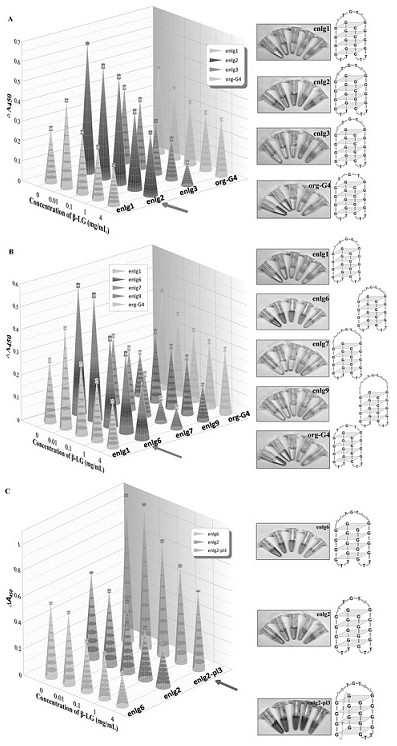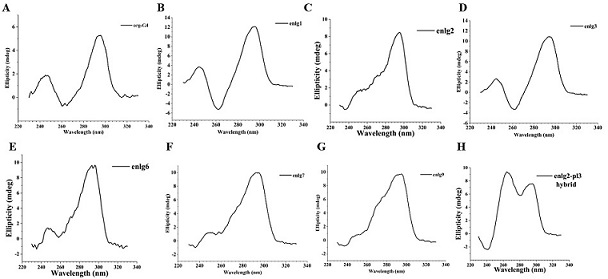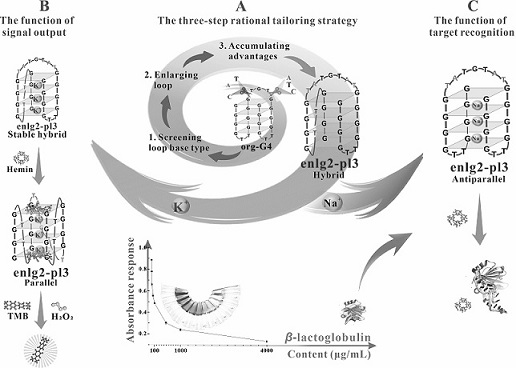Difunctional G-quadruplex allosteric biosensor for detecting beta-lactoglobulin
A biosensor, lactoglobulin technology, applied in the field of bifunctional G-quadruplex allosteric biosensor, can solve the problems of difficult real-time detection, high assembly cost, limited application, etc., to expand application breadth and improve detection The effect of sensitivity
- Summary
- Abstract
- Description
- Claims
- Application Information
AI Technical Summary
Problems solved by technology
Method used
Image
Examples
Embodiment 1
[0051] Example 1. Design of β-lactobulin fitting
[0052] 1. Exclusions of different base pairs in the center region of the beta-lactone protein fitting
[0053] At present, there is a need to introduce signal output elements based on the application of the adapter detection of β-mulldine. In order to obtain a beta-lactobulin fitting body having a target identification and signal output dual function, the original β-milk globulin is suitable The ligand is designed and the design results were verified by circular diometric spectroscopy and TMB colorimetric experiments. First, 1 pair T, A, C base is introduced in the central ring region of ORG-G4 (SEQ ID NO.1), respectively, and the sequence is named Enlg1 (SEQ ID No. 2), Enlg2 (SEQ IDN.3) ) And enlg3 (SEQ ID No.4).
[0054] The ability to form a G-tetra-chain structure in different sequences is evaluated by circular dichro spectroscopy. 20 μL 60 μmol·L -1 Different sequences and 20 μL 60 μmol·L -1 Hemin and 160 μL G-tetracene incub...
Embodiment 2
[0084] Example 2. Detection Performance Evaluation of β-Millerin Biosensor
[0085] 1. Principle of detection of beta-lactobulin biosensor
[0086] In order to construct a double function, the adaptive biosensor is used for β-lactobulin detection, by modifying the original ligand ORG-G4, the anti-parallel G-tetra-chain structure is transformed into anti-parallel / parallel mix g - Tetracemic structure, the design of the adapter ENLG2-PL3 has a double function with signal output and target recognition ( image 3 . When the beta-milkurogin is absenced in the detection system, the Enlg2-PL3 is k + Ion-induced folds into a stable mixed parallel structure, and then form a parallel G-tetracene topology in the presence of HEMIN. Only when parallel G-tetracene is assembled with chlorin chlorin, the complex has a hydrogen carboase activity, which can catalyze the TMB substrate reaction to cause blue, and after the sulfuric acid solution is terminated, the solution is yellow, basis The absor...
Embodiment 3
[0093] Example 3. Optimization of detection conditions of beta-lactobulin biosensor
[0094] Optimized the pH of the G-tetracell incubation liquid and the K + NA + The concentration was also optimized for the pH of the TMB color culture. The optimization conditions are divided into 8 groups depending on the pH and ion content of the solution into 8 groups, named M1 to M8. 10 μL 40 μmol·L -1 Enlg2-PL3 and 10 μL 60 μmol·L -1 Hemin, 10 μL 0, 10, 100, 1000 and 4000 μg · ml -1β-lactone protein and 40 μL G-tetracene incubation liquid (specific component Image 6 A) mix, 37 ° C for 20 min, 30 μL of 0.8 μmol·L -1 TMB color culture (pH 3.9 and 8.4) was added to the reaction mixture for 20 min catalytic reaction. Subsequently, 30 μL 2 mol·L -1 Hide 2 SO 4 The solution is terminated to the catalytic reaction. Finally, the absorbance was measured at 450 nm using the enzyme label. The activity change of DNA bionic enzymes before and after the addition of the experimental group and the control g...
PUM
 Login to View More
Login to View More Abstract
Description
Claims
Application Information
 Login to View More
Login to View More - R&D
- Intellectual Property
- Life Sciences
- Materials
- Tech Scout
- Unparalleled Data Quality
- Higher Quality Content
- 60% Fewer Hallucinations
Browse by: Latest US Patents, China's latest patents, Technical Efficacy Thesaurus, Application Domain, Technology Topic, Popular Technical Reports.
© 2025 PatSnap. All rights reserved.Legal|Privacy policy|Modern Slavery Act Transparency Statement|Sitemap|About US| Contact US: help@patsnap.com



